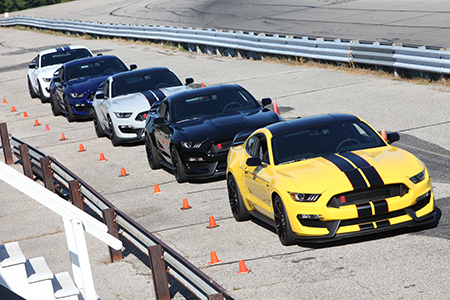A Classic Sixties Mustang Gets a Makeover
by Natasha Wolff | September 3, 2015 10:00 am
Fifty years ago Carroll Shelby took delivery of a stock Ford Mustang at his facility in Venice Beach and, after several performance modifications, created the iconic GT350, a race-spec masterpiece that defined an era and set a standard for American performance cars[1]. To commemorate the anniversary, Ford has debuted a new generation of the GT350. Three years in the making, the car is true to the spirit of a competitive, trackable production road car, but seeing as we’re half a century out from its inception, Ford Performance engineers acknowledge that much has changed in speed and safety technology since 1965.
The legacy of American performance cars has largely been defined by raw power. However, Jamaal Hameedi, Ford Performance’s Chief Engineer, freely admits that the development process of this new generation was equally informed by foreign automakers who design for balance over brawn. He took a long look at the Porsche[2] 911 Carerra, for instance, in setting some of their targets — a departure for a company that fixated on how it measured up against Chevrolet or Chrysler.
They’ve taken a mixed bag of influence and inspirations to produce a remarkable car with several innovations. Most notably, a naturally aspirated flat-plane crank V8 engine codenamed “Voodoo” (the only other manufacturer to do so is Ferrari) and carbon fiber wheels (Ford is the first major automaker to offer them on a production car).

The new Ford GT350 Mustang
The GT350 they’ve delivered meets or exceeds its European counterparts, but starting at around $50,000 can be had at a fraction of its competitor’s sticker price. We had an opportunity to drive both iterations of the new Mustang (the track package GT350 and the stripped-down, suped-up GT350R) at Laguna Seca Raceway and hopped in expecting to encounter some of the usual limitations of an American nouveau pony car—off-the-shelf understeer, a nausea-inducing high water line that limits driver vision, and a general favoring of power over control.
Hameedi explains that when their engine team surpassed the performance benchmarks (set at 500hp and they delivered 526hp), the focus of the development process was able to shift to vehicle dynamics. “We knew that if we get the front end of this car right, the rest is just gravy,” he says. They got it right. The car negotiated Laguna Seca’s signature section, turns 8-9 with an elevation drop of 110 feet that includes the (in)famous corkscrew, with an ease equal to many of its higher-priced competitors. Hameedi proudly states that the new Shelby GT350, to use a boxing analogy, “punches well above its weight class.”
My advice is to buy two. Drive one straight to your nearest track and lap it until the specially designed tri-compound Michelin Pilot Sport Cup 2 tires are worn bare and stash the other one away, as this will surely be as sought after a car as its 1965 ancestor (that can now fetch as much as half a million at auction) come 2065.
- American performance cars: http://dujour.com/lifestyle/american-muscle-cars/
- Porsche: http://dujour.com/lifestyle/porsche-north-american-headquarters-experience-center-pictures/
Source URL: https://dujour.com/life/ford-gt350-mustang-car-details/